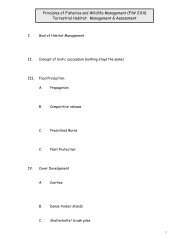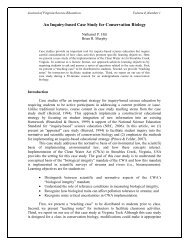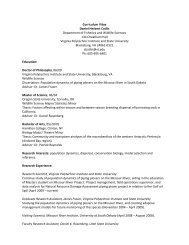Kernel Home Range Estimation for ArcGIS, using VBA - Fish and ...
Kernel Home Range Estimation for ArcGIS, using VBA - Fish and ...
Kernel Home Range Estimation for ArcGIS, using VBA - Fish and ...
You also want an ePaper? Increase the reach of your titles
YUMPU automatically turns print PDFs into web optimized ePapers that Google loves.
iweight kernel (this is an unexplained discrepancy between Seaman <strong>and</strong> Powell, 1996 <strong>and</strong><br />
Silverman, 1986).<br />
Given a true density function <strong>for</strong> some distribution of data (Figure 4.3.2.1.a.), various values of h<br />
(the smoothing parameter) are used to obtain density estimates. For example, Figure 4.3.2.1.b.<br />
shows the density estimate given a smoothing parameter smaller than the optimum (or true)<br />
value. The difference between the estimated <strong>and</strong> true density is evaluated as the sum of the area<br />
of deviation of the estimate from the true density. Figure 4.3.2.1.c. shows that difference given a<br />
smoothing parameter slightly larger than the optimum value.<br />
a b c<br />
Figure 4.3.2.1. Least-Squares Cross-Validation with the true density (black line) (a) <strong>and</strong> an over-<br />
(yellow line) (b) <strong>and</strong> under-estimate (blue line) (c) of the smoothing parameter.<br />
Finally, with highly oversmoothed data, as with a smoothing parameter that is considerably larger<br />
than optimum (Figure 4.3.2.2.a.), the difference between the density estimate <strong>and</strong> the true density<br />
is large. The loss function can be considered to be the difference in area between the estimate<br />
<strong>and</strong> the truth. In this case it is the area difference, but in home range estimation, with bivariate<br />
data, the loss function would be the difference in volume between the two surfaces. In reality this<br />
loss function is the integrated square error (integrated since we are dealing with a density, <strong>and</strong><br />
square error, since we want to incorporate error in both over- <strong>and</strong> under-estimation). It is intuitive<br />
that we want the smallest deviation from the truth, <strong>and</strong> thus, when we plot the integrated square<br />
error <strong>for</strong> various smoothing parameters (Figure 4.3.2.2.b.), we search <strong>for</strong> the absolute minimum<br />
on the curve. At this point we find the associated smoothing parameter, which becomes our<br />
estimate of the optimum smoothing parameter.<br />
18









